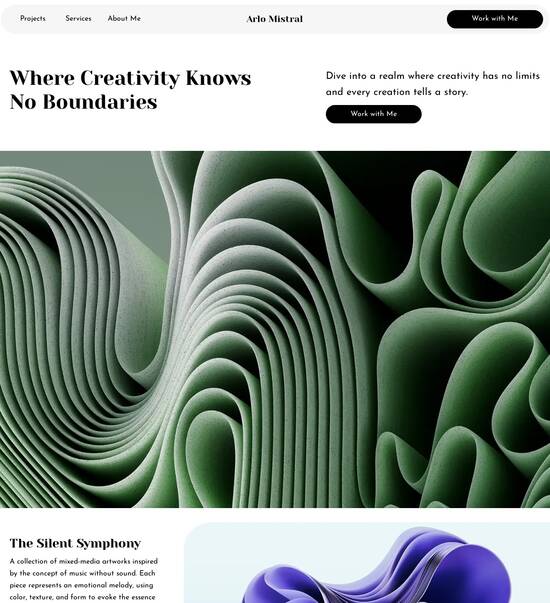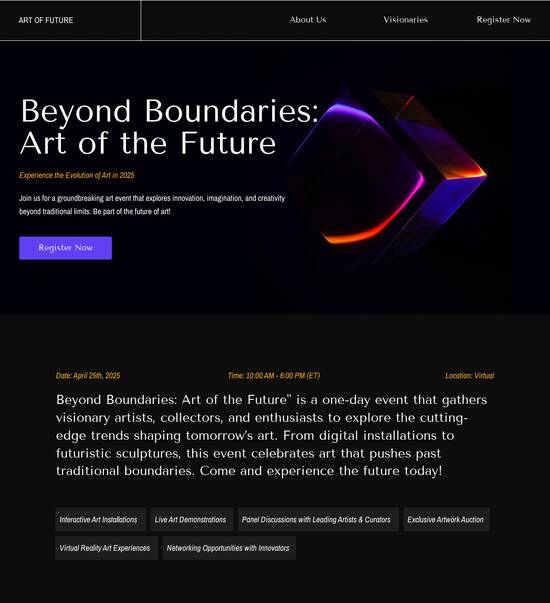
Interactive glossary page template
Explore Similar TemplatesAbout template
Unleash your creativity with the interactive glossary page template. Try Instapage today.
Recommended templates

Easy to build without coding
With the intuitive drag-and-drop builder, anyone on your team can create high-converting pages without any knowledge of code or design. Make enhancements to your landing page with custom widgets using Javascript, HTML/CSS, or third-party scripts.

Multiple layouts for any industry and goal
Select from 500+ landing page layouts built to boost conversions across industry-specific scenarios. Customize them by adjusting fonts, adding images, and generating on-brand content with the AI assistant. Quickly scale with Instablocks® and Global Blocks that you can save, reuse, and update globally.

Loads fast and looks polished on any device
Every template is responsive, which means they present professionally on any device and load blazingly fast with our Thor Render Engine. You can also power them up with Google AMP technology to deliver an unparalleled mobile experience and drive higher conversions.

Robust analytics & experimentation
Get real-time updates and reporting across all your devices, showing the number of visitors, conversions, cost-per-visitor, and cost-per-lead. Launch AI-powered experiments, run A/B tests, and use heatmaps to analyze user behavior, then optimize your landing page to maximize conversions.







Easy to build without coding
With the intuitive drag-and-drop builder, anyone on your team can create high-converting pages without any knowledge of code or design. Make enhancements to your landing page with custom widgets using Javascript, HTML/CSS, or third-party scripts.
Multiple layouts for any industry and goal
Select from 500+ landing page layouts built to boost conversions across industry-specific scenarios. Customize them by adjusting fonts, adding images, and generating on-brand content with the AI assistant. Quickly scale with Instablocks® and Global Blocks that you can save, reuse, and update globally.
Loads fast and looks polished on any device
Every template is responsive, which means they present professionally on any device and load blazingly fast with our Thor Render Engine.
Robust analytics & experimentation
Get real-time updates and reporting across all your devices, showing the number of visitors, conversions, cost-per-visitor, and cost-per-lead. Launch AI-powered experiments, run A/B tests, and use heatmaps to analyze user behavior, then optimize your landing page to maximize conversions.
All the features you need to build lead-generating landing pages
Explore more featuresLearn how to build top-performing landing pages for any goal
FAQs
Leading the way in building high-performing landing pages





An effective step-by-step guide to mastering Instapage landing pages
Optimizing your marketing campaigns requires a solid understanding of landing pages, and Instapage offers the utmost capabilities for creating high-converting pages. In this guide, we'll delve into the essential steps for leveraging Instapage’s powerful features, enabling you to enhance your marketing strategy effectively.
Understanding Instapage’s core offerings
Instapage stands out as a versatile landing page and conversion rate optimization platform tailored for marketers across various industries. With its user-friendly interface and wide array of features, Instapage makes it simple to create pages that engage visitors and boost conversions. Here are some of the standout features:
- Pre-built templates: Choose from over 100 high-converting templates to kickstart your campaign.
- Dynamic text replacement: Personalize messages to align with your audience’s interests effortlessly.
- A/B testing: Test variations of your pages against each other to see what resonates best with your audience.
Creating your first landing page with Instapage
Getting started with Instapage involves several straightforward steps. First, you should account for the specific goals of your digital marketing campaign. Here’s how to build your first landing page:
- Select a template: Choose a template that matches your campaign needs from the extensive library.
- Customize the page: Use drag-and-drop tools to modify text, images, and elements to better suit your brand.
- Preview and publish: Always preview changes on mobile and desktop before publishing to ensure the best user experience.
Optimizing landing page performance
No landing page is complete without diligent optimization. Performance can be boosted by focusing on a few key strategies:
- Integrate analytics tools: Utilize Instapage’s built-in analytics to measure your page’s performance and traffic sources.
- Set up A/B tests: Evaluate effectiveness by running tests on various elements like CTAs, images, and headlines.
- Employ heatmaps: Analyze user engagement with heatmaps to spot potential drop-off points on your pages.
By following these steps, you can maximize the effectiveness of your landing pages on Instapage.
In conclusion, tapping into the full potential of Instapage can significantly enhance your digital marketing efforts. With its myriad of features, you can create and optimize high-impact landing pages in mere minutes.
Take the first step towards transforming your marketing campaigns. Sign up for Instapage today to access powerful tools designed to elevate your performance.
People also ask about Interactive glossary page template
Interactive glossary page template: Unpacking a dynamic resource for enhanced user engagement
Understanding the essence of an interactive glossary
An interactive glossary serves as a versatile tool that defines and elaborates on specific terms, concepts, and jargon within a particular field or subject. Unlike a traditional glossary, which simply lists definitions, an interactive glossary allows for a richer, immersive experience by integrating multimedia elements, hyperlinks, and user engagement features. This transforms a static list into a dynamic resource that enhances understanding and retention.
The main distinction between static and interactive glossaries lies in user engagement. A static glossary merely presents terms and definitions, whereas an interactive glossary employs various elements — such as audio pronunciations, images, and quizzes — to facilitate deeper learning. This interactivity not only aids comprehension but also fosters an environment where users feel more inclined to explore.
The target audience for an interactive glossary includes students seeking help with complex concepts, educators who want to integrate engaging resources into their teaching, and industry professionals needing quick references of terminology in their fields. These users often benefit significantly from the interactive aspect, allowing for immediate clarification and extended exploration into related topics.
The anatomy of an interactive glossary page template
To create an effective interactive glossary page template, several core components must be incorporated. Firstly, it should include a comprehensive list of terms accompanied by precise definitions. This set of foundational elements allows users to grasp essential jargon quickly. Furthermore, embedding multimedia elements such as videos or audio clips can elevate the learning experience, bringing an auditory or visual dimension to definitions.
User navigation features are also crucial for an interactive glossary. Incorporating a search function allows users to find specific terms quickly, while intuitive navigation aids ensure that users don't feel lost while exploring definitions and multimedia. These features collectively provide a better user experience, catering to individuals who prefer different learning styles.
Terms and definitions
Embedded multimedia elements
User navigation features
In addition to core components, the design and layout of the glossary are paramount. The visuals should be engaging while maintaining user-friendliness. Color schemes and font choices play significant roles in readability and appealing design. Responsive design is essential, ensuring the glossary is accessible on various devices, from desktops to mobile smartphones.
Content structuring is another essential aspect. Glossaries can be arranged alphabetically or organized into categories based on themes or subjects. This facilitates easier navigation and quick access to relevant terms. A search functionality further enhances the user experience, allowing users to filter and locate terms as needed.
Creating the interactive experience
To create an engaging user experience, an interactive glossary should include features that not only attract users but also encourage their interaction. For example, hover-over definitions allow users to quickly access explanations without having to navigate away from the current page. Clickable terms that link to in-depth articles or external resources offer users additional context, stimulating further exploration of subjects.
In addition to traditional definitions, integrating multimedia elements significantly boosts engagement. This can range from short videos explaining terms to audio pronunciations that assist in correct term usage. Infographics that visually represent complex ideas can also be beneficial. Platforms like Notion can facilitate the creation and sharing of interactive glossaries, making it easier to manage multimedia content along with definitions.
Hover-over definitions
Clickable terms linking to detailed explanations
Embedded videos and audio pronunciation
Optimizing with conditions: Personalizing user experience
Offering user customization options can significantly enhance the experience of your interactive glossary. Allowing users to filter or sort terms based on relevance, popularity, or user-defined categories creates a tailored experience. When users can adjust their content-viewing preferences, they are more likely to engage deeply with the material provided.
Contextual condition settings add an additional layer of personalization. These settings can adjust definitions based on user interaction, displaying more relevant definitions or examples based on previous searches. This approach not only makes the glossary more user-centered but could also help address diverse learning styles prevalent among different user groups.
Download resources and accessibility features
The provision of downloadable resources is an important consideration when designing an interactive glossary. Allowing users to download glossary terms in PDF format ensures that they have offline access to information when needed. This can be particularly beneficial for students looking to integrate terms into their digital learning environments or incorporate them into assignments.
Accessibility considerations must also be at the forefront of interactive glossary design. Compliance with the Web Content Accessibility Guidelines (WCAG) ensures that all users, including those with disabilities, can effectively navigate and utilize the glossary. Providing text-to-speech features can assist visually impaired users, while captions for multimedia content also enhance inclusivity.
The learning impact: How interactive glossaries enhance retention
Interactive glossaries offer cognitive benefits that significantly improve term retention among users. Engagement strategies, such as embedding quizzes or flashcard functionality, can reinforce learning while making it enjoyable. Users often find that incorporating gamification elements encourages ongoing interaction, which can lead to improved memory retention of key terms.
In educational settings, interactive glossaries streamline student learning experiences. Several educational institutions have effectively implemented these tools, resulting in increased student engagement and retention rates. By providing an engaging platform for students to explore new terminology, these institutions are effectively enhancing the learning process.
In the corporate world, the implications of using interactive glossaries extend into training and development programs. Companies often utilize these resources for onboarding processes, equipping new employees with essential terminology, and promoting continuous learning. This not only facilitates knowledge retention but also creates a more knowledgeable workforce.
Metrics for success: Evaluating effectiveness and engagement
Understanding the effectiveness of an interactive glossary can be achieved through analyzing user interaction metrics. Key performance indicators (KPIs) to consider include engagement rates, the time users spend on the page, and the popularity of specific terms searched. By tracking these metrics, developers can assess how well users are receiving and interacting with the glossary.
Mobile analytics tools can provide further insights into how users are navigating the glossary, which features are most engaging, and where users tend to drop off. This data is invaluable in informing decisions about content modifications or additions to optimize the user experience.
Establishing feedback loops is essential for continuous improvement. Gathering user feedback through surveys or suggestion forms allows developers to adapt and enhance the glossary, ensuring it remains relevant and useful. Additionally, using user data to iteratively update the glossary can help keep the content fresh and engaging.
Case studies: Success stories of effective implementation
Several organizations have successfully implemented interactive glossaries, reaping notable benefits. For instance, one educational institution developed an interactive glossary that resulted in a measurable increase in student engagement and understanding of technical terms. The use of multimedia and interactive features allowed students to grasp complex content with greater ease.
Another case study showcases a corporate training program that incorporated an interactive glossary to assist in onboarding new employees. The glossary equipped them with essential industry terminology and resources, yielding positive feedback regarding the clarity and effectiveness of training materials. Organizations learned valuable lessons about customization and incorporating user-centric features to improve user experiences.
Future trends in interactive learning resources
Looking ahead, technological innovations promise to transform the landscape of interactive glossaries. Potential advancements, such as AI-driven definitions and machine learning applications, could facilitate highly personalized user experiences. These technologies may help identify user preferences and adjust content delivery to better suit individual learning styles.
Further expanding functionality may include integrating additional features across digital platforms. Future interactive glossaries might incorporate social sharing capabilities and collaborative tools, fostering greater user involvement and community learning experiences. This proactive approach to content delivery will likely keep users engaged and invested in the glossary, ensuring it remains a vital resource.
Key takeaways and final thoughts
In summary, interactive glossaries represent a key resource for enhancing user engagement and learning retention. By providing an array of multimedia elements, user-friendly navigation, and customization options, they cater to diverse learning styles and needs. The importance of accessibility and inclusivity further highlights their potential for promoting wider knowledge dissemination.
Ultimately, the transformative power of interactive glossary templates spans various sectors, from education to corporate training. Why not explore this tool and consider how it could serve your audience better? By implementing these strategies and considering future trends, your interactive glossary could significantly contribute to user engagement and learning outcomes.
Ready to skyrocket conversions?
Supercharge your ad campaigns with high-performing landing pages
Get started














